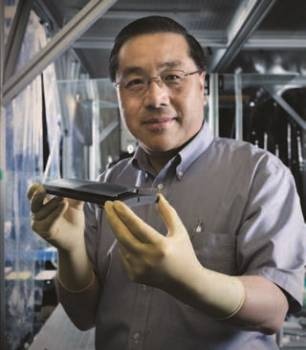Jul 30 2019
Recently, it has been proved that lightweight, super-thin X-ray mirrors produced from a material generally used for making computer chips are capable of meeting the rigid imaging requirements of next-generation X-ray observatories.
 Goddard scientist Will Zhang holds mirror segments made of silicon. These X-ray optics have been baselined for the proposed Lynx X-ray Observatory. (Image credit: Chris Gunn/NASA)
Goddard scientist Will Zhang holds mirror segments made of silicon. These X-ray optics have been baselined for the proposed Lynx X-ray Observatory. (Image credit: Chris Gunn/NASA)
The X-ray mirror technology currently under development by Will Zhang and his team at NASA’s Goddard Space Flight Center in Greenbelt, Maryland, has thus been baselined for the Design Reference Mission of the conceptual Lynx X-ray Observatory. This is one of the four probable missions assessed by scientists as notable pursuits under the 2020 Decadal Survey for Astrophysics.
If this new technology gets selected and launched in the 2030s, Lynx will be able to accurately carry tens of thousands of Zhang’s mirror segments, thus offering a two-orders-of-magnitude leap in sensitivity over NASA’s most important Chandra X-ray Observatory and the European Space Agency’s Advanced Telescope for High-Energy Astrophysics, or Athena.
When it was launched in 1999, Chandra itself offered a noteworthy leap in capability. Chandra is capable of observing X-ray sources (matter around black holes, clusters of galaxies, and exploded stars) 100 times more obscure than those observed by earlier X-ray telescopes.
Zhang and his team came up with another development that helped in securing a nearer-term flight opportunity aboard a sounding rocket mission planned for 2021. The development will represent the technology’s first demonstration in space.
Seven-Year Development Effort
Work started on the new optic when Zhang’s experimentation with mono-crystalline commenced seven years ago. Mono-crystalline is a single-crystal silicon that was never used to develop X-ray mirrors. These fabricated optics will have to be curved and then securely placed within a cylindrically shaped container to allow high-energy X-ray photons to graze their surfaces and bounce into an observatory’s instruments instead of passing through them.
The cost of building space observatories increases as they get heavier and large. Considering this fact, Zhang aimed at developing lightweight, easily reproducible, super-thin mirrors by maintaining good quality.
“What we’ve done is shown from a scientific perspective and empirically that these optics can be built” using a reasonable, abundantly available material resistant from the internal stresses that can alter the shape of X-ray mirrors produced from glass, the standard material used for making mirrors.
A NASA-commissioned panel of 40 specialists conducted reviews and stated that Zhang’s optics produced from the brittle, extremely stable silicon material are capable of the matching image quality as the four pairs of heavier and larger mirrors flying on Chandra. The panel also believed that two other technologies—adjustable optics and full-shell mirrors—will be able to meet the demands of the conceptual Lynx Observatory.
Besides being able to provide 0.5 arc-second resolution equivalent to the image quality delivered by ultra-high-definition television, Zhang’s mirrors also met his low-mass requirements. Zhang stated that these mirrors are 50 times thinner and lighter than Chandra’s—meaning that future observatories will be able to carry more mirrors, producing a bigger collection area for capturing X-rays originating from high-energy phenomena in the universe.
The Difficult Part Begins
However, Zhang stated that he and his team are still “far, far away from flying our optics.”
Zhang and his team of engineers will currently have to understand how to link these delicate mirror segments within the canister, which shields the whole mirror assembly in the course of a rocket launch and maintains their nested arrangement.
We have a lot to do, and not a lot of time to do it. This is now an engineering challenge.
Will Zhang, Scientist, Goddard Space Flight Center, NASA
Zhang further pointed out the importance of time. Two years from now, Zhang’s team will have to deliver a 288-segment mirror assembly to Randall McEntaffer, a professor at Pennsylvania State University in State College. McEntaffer is producing a sounding rocket mission known as the Off-plane Grating Rocket Experiment (OGRE), which is planned for launch from the Wallops Flight Facility in 2021.
Along with the mirrors, OGRE will carry a spectrograph developed by the university and furnished with next-generation X-ray diffraction gratings used to divide X-ray light into its component colors or wavelengths in order to disclose an object’s chemical makeup, temperature, and several other physical properties.
Zhang added that OGRE will do much to improve the mirror assembly. This mission will assist in determining whether the team’s design is capable of protecting the delicate nest of mirrors from intense launch forces experienced during liftoff and ascent via the Earth’s atmosphere.
Further Opportunities Available
Zhang foresees a successful future for the team’s optics. Even if Lynx is not selected for development by the 2020 Decadal Survey, other projected missions will benefit, Zhang said. These include a few X-ray observatories at the moment being explored as prospective astrophysics Probe-class missions and another one are presently being considered by the Japanese.
Five years ago, people said it couldn’t be done, but we proved our ideas. My team is grateful to Goddard’s Internal Research and Development program for giving us the seed money. We couldn’t have achieved this without it.
Will Zhang, Scientist, Goddard Space Flight Center, NASA
Cheaper, Lighter, Better - Making the Next Generation X-ray Mirrors.
X-ray observatories like Chandra give us a new view of our universe beyond what we can see with our eyes. Now a team at NASA’s Goddard Space Flight Center is working to take X-ray astronomy to the next level. Goddard astrophysicist Dr William Zhang believes his mirrors can show us what is happening near supermassive black holes like the one in the center of our Milky Way galaxy. Here is how the mirrors come together. (Video credit: NASA)